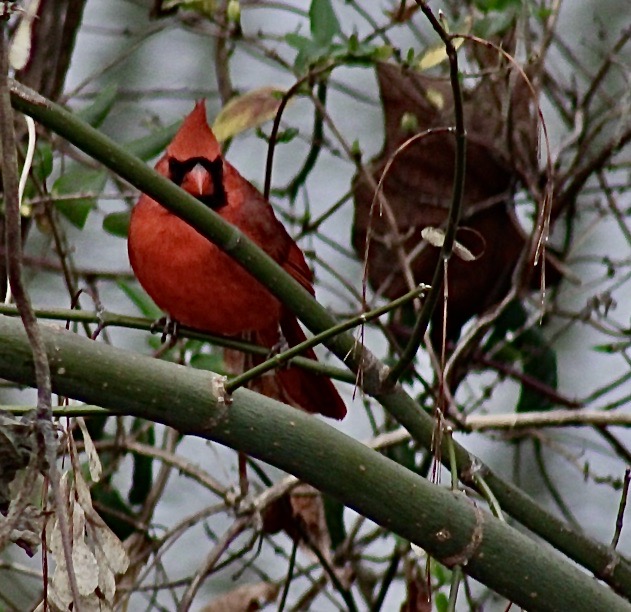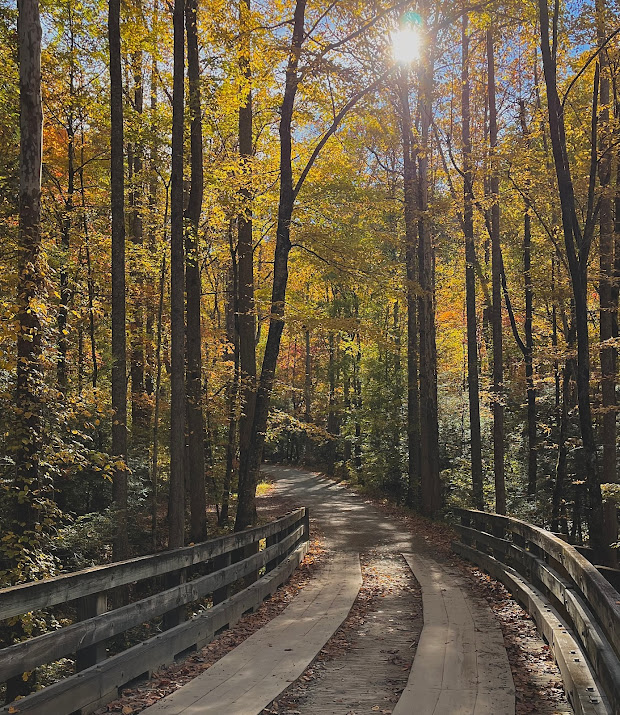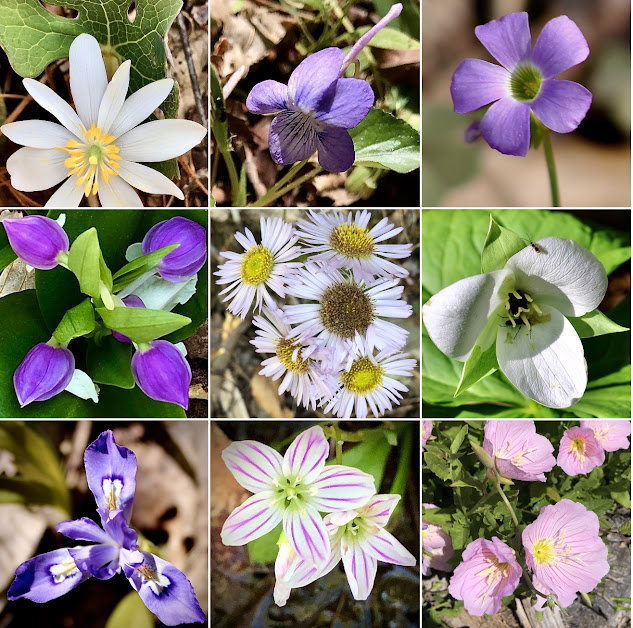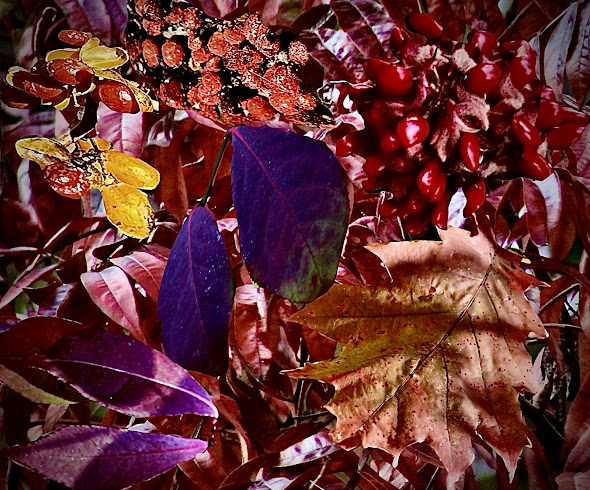Male Northern Cardinals Digital Reflective Nature Journal
Male Northern Cardinals A Special Bird
I know I want to capture this beauty with one or more photographs today. Can I record this image and even get more time to write later using the Northern Cardinal photographs for personal reflections and writing prompts?
I continue my December 12, 2022 Nature Journal from my in the field experiences with these bright red male Cardinals. I was on a photography exploration on the Maryville Tennessee Greenway trail where Browns Creek empties into the upstream end of the Greenbelt Lake.
I had been working my way upstream of the Parham Avenue bridge watching both sides of Browns Creek while walking, stopping, listening, and looking to be fully aware. I wanted to photograph birds or small mammals in this place I often visit to document all of the urban biodiversity of this Greenbelt system.
I had circled around and crossed Browns Creek about 150 yards upstream on the Harper Avenue Bridge. I went through some commercial parking lots and got back on the Lincoln Road Greenway Trail when I saw a brown head peering at me just up the hill from the trail. This Groundhog was here then suddenly gone. I guess it went back into its network of underground dens under all the frozen and brown Kudzu vines.
I walked back down the hill above the creek and went under the high overhead Hall Road five-lane bridge. I was back creek side and was slowly walking and listening for birds or other life forms. My eyes were aware of any movement along the creek and the 20 feet view across to the other side of the stream bank.
I continued heading towards the Bridge where Browns Creek enters the Greenbelt Lake. There are two large American Sycamore trees, one on either side of the creek next to the bridge. Some vines and other plant growth provide cover and perching places for Sparrows, Juncos, Cardinals, Bluejays (picture above of its back), Northern Mockingbirds (picture below with its tail up) , and other birds I have seen and photographed here.
I have captured Red-bellied Woodpeckers on my camera here before and the one below on this day has its head and beak pointed up high.
Today I also photographed a Yellow- bellied Sapsucker with its red throat and red topped head, that was pecking away high up in a tree.
As I was researching more information about Northern Cardinals I went to a favorite Aves resource. All About Birds from the Cornell Lab Ornithology has several links to a search for Cardinals. I was looking for some interesting information and ran across this link. It answered this question:
Why do they have gray on wings, back and tail and are not all bright red in the winter?
Click the blue link below for full article
Are Cardinals Redder in Winter?
I added several quotes from this website article below.
“Northern Cardinals molt their feathers and grow new ones in late summer and early fall, after the breeding season is over and at a time when food is abundant.”
“A newly molted male cardinal isn’t at his brightest. Many of his new feathers, especially on the neck and back, are tipped with gray. During fall and winter these dusky feather tips slowly wear off, revealing more and more brilliant red.”
“The birds reach the peak of brilliance by midwinter ahead of the spring breeding season. Against snow- covered conifers, it’s a feast for our eyes, too.”
“The richness of a male’s red feathers may make a difference in his reproductive success: One study found that in rural areas, brighter red cardinals tended to mate earlier and nest in higher-quality habitat—factors usually associated with more offspring."
For urban cardinals “The redness in cardinals comes from carotenoids, pigments that occur naturally in foods such as red and purple fruits.”
“Honeysuckle is often planted in urban gardens and woodlands and has red berries that some cardinals feast upon. Honeysuckle berries are high in carotenoids, but unlike native fruits such as dogwood and winterberry, they’re very low in fats and proteins."
I was seeing lots of these plants with sometimes heavy infestation and thick growth along the Greenway trails. The Amur (Bush) Honeysuckle with its late summer and fall red berries might be the Pistol Creek dominate stream side bush.
This Cardinal in the top of an Amur Honeysuckle bush, was taken on November 2, 2022 a few miles away in the Alcoa TN Springbrook Park section of the Greenbelt system. He shows the gray tints to his back, wing, and tail feathers.
Japanese Privet with its blue berries, also has some heavy infestation along sections of the Greenway trails. Bradford Pears trees are another ornamental plant with small fruits that are not natives to the USA that I also have observed in many places on the Greenway.
These two pictures of Cardinals in these two invasive plants feeding, were from December 10, 2022 and located just below the Greenbelt Lake on the Greenway trail.
These Cardinals are feeding on the fruits and berries of these plants with less nutrition values than native plants which could account for their gray plumage.
In the next photo look at the Privet dark blue berry in his beak. The second photo shows some remnants of the Bradford pear fruit still on his beak.
I also have researched other resources for ideas to develop writing prompts for my Nature Photography. After the next three Cardinal Photos and the line reflections are a list of the four prompts I used to guide my writing as I will close this
Closer to Nature.... Blog Post
Left click on each photo for a better view in a gallery format.
I urge you to try these different writing prompts for connecting to nature, scenes, sketches you might have drawn, paintings, or photographs. They can be modified or changed to match who you are or what you are feeling at the time of your Nature encounters.
Four line prompts to write and connect you to your image
First Line- the outer perspective-what it is
Second Line- the inner experience, it’s nature and qualities. I often add personification of giving other life human qualities
Third Line- the secret view, what is close and true
Forth line- Find a closer connection to myself and to my inner feelings in the here and now
Or even past fondness or hurts of my life
Or gazing into future personal wishes, and even dreams for my future
Three simple ways to start a reflection about a moment in Nature
I notice....
I wonder....
Reminds me of...
Thanks for viewing and please leave comments or share this with friends.

























Comments
Post a Comment